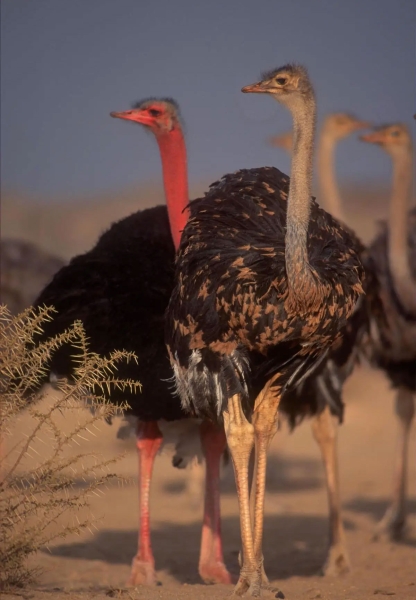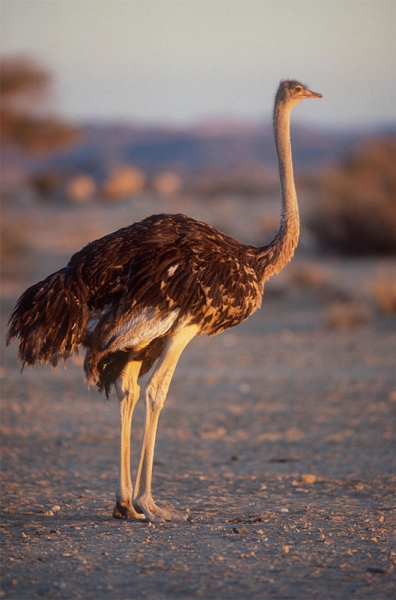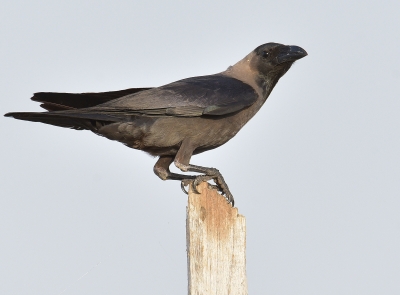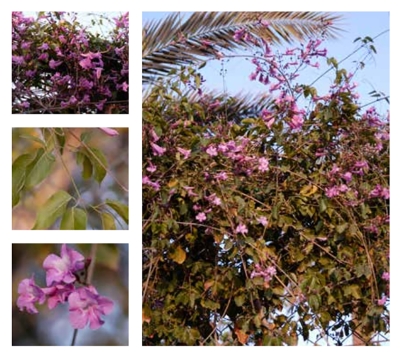


The Arabian Ostrich (scientific name: Struthio camelus syriacus) is an extinct species of ostrich that was once widespread across al-Rub' al-Khali (Empty Quarter) Desert until 1910 and north of the Kingdom of Saudi Arabia until the 1960s. It was last spotted in al-Qurayyat Governorate, al-Jawf Province.
The history of the Arabian ostrich in Saudi Arabia
Arabian ostrich species originally were widespread across the Arabian Peninsula and the Near East. Due to the desertification during the Holocene geological era and the drought of lakes in al-Rub' al-Khali (Empty Quarter), its subspecies declined into just two groups: a smaller one in the southeastern part of the Arabian Peninsula and a larger one in the region bordering the Kingdom, Jordan, Iraq, and Syria, as well as in Palestine and the Sinai Peninsula. The highest population was in al-Jawf Governorate, north of the Kingdom, bordering Jordan, since the Arabian ostrich was closely associated with herds of now-extinct Saudi Gazelle (Gazella saudiya) and Arabian oryx (Oryx leucoryx). Arabian ostriches were depicted in rock inscriptions and drawings discovered in the Kingdom, showing ostriches chased with arrows and slingshots and hunted by humans, as well as females with their chicks.
The characteristics of the Arabian ostrich environment and its previous presence in the Arabian Peninsula were described by the British explorer William Gifford Palgrave during his 1862 expedition in Wadi as-Sirhan, northwest of the Kingdom. He said, "In this region, we encountered a large herd of ostriches. These ostriches are the most elegant birds inhabiting this land and the most difficult to approach. When we saw the ostriches from afar, running one after another in a long line, we mistook them for a herd of frightened camels."
In his book "In Unknown Arabia," published in 1962, the British explorer and traveler Robert Ernest Cheesman recounted that when he visited al-Hufuf to collect bird specimens and study its wildlife, he met King Abdulaziz on January 16, 1924. During this meeting, Cheesman informed the king about the arrival of the Arabian ostrich that he had sent to Sir Percy Cox in London, where many people had gone to see it.
Geographic scope of Arabian ostrich
According to the World Bird Data Base, the Arabian ostrich's inhabitation scope formerly included eastern Africa, north and west of the Sahara Desert, and south of the rainforest belt, as well as a significant portion of Minor Asia and the Arabian Peninsula. Excessive hunting led to the extinction of the Arabian ostrich by the mid-twentieth century. The last reported Arabian ostrich died in Wadi al-Hasa, north of Petra, Jordan in 1966.
Arabian ostrich classification
The Arabian ostrich is scientifically classified within the Kingdom Animalia, Phylum Chordata, Class Aves, Order Struthioniformes, Family Struthionidae, Genus Struthio, and Species Struthio camelus. Its scientific name is "Struthio camelus syriacus."
Arabian ostrich description
Compared to other ostrich species worldwide, the Arabian ostrich was known for its ability to withstand harsh climatic conditions. Males were characterized by their black plumage, known as (Khamal), with white tips, while females were known by their abundant, lighter brown feathers. The male ostrich is called 'al-Thaleem',and its plural is 'Thulman'. It is characterized by its aggressive behavior, especially during mating season. Its height is estimated to be between 450 and 530 mm. The ostrich chick is called "al-Reel".
The Arabian ostrich lived in small groups, comprising several females with one male.
Due to their substantial size and weight, ostrich eggs are highly resistant to natural erosion over the years. A female ostrich lays between thirty and fifty eggs annually, each weighing up to 1.5 kg.
The Arabian ostrich was hunted with its meat to be eaten, while skin and feathers were used in handicrafts. Beyond its native range, the ostrich was a delicacy in Mesopotamian civilizations, and its image adorned their vessels. Greek texts from the Assyrian period document the export of live ostriches to China as valuable gifts to the emperor. The people of that region were known to ride ostriches, taking advantage of their strong necks and swift speed.
Arabian ostrich eggshells
Before its extinction, the Arabian ostrich inhabited gorges and sandy regions of the Arabian Peninsula. This was evidenced by the discovery of its eggshells, particularly in al-Rub' al-Khali (Empty Quarter). Evidence also included naming some places after ostriches, ancient inscriptions, and depictions of the bird in Arabic literature, such as al-Jahiz's Book of Animals and Ibn Manthur's Lisan al-Arab.
Remnants of Arabian ostrich eggs have been scattered across the deserts of the Arabian Peninsula. Photographer and explorer Abdullah Philby collected some shells during his 1931 expedition to the Empty Quarter. Similarly, members of the 'Reviving the Heart of the Arabian Peninsula' expedition, led by explorer Mark Evans and a team of researchers, collected some shells in Nufud Qulakan in early 2023. Additionally, shell fragments are widespread in the Uruq Bani Ma'arid Reserve, located on the southwestern edge of the Empty Quarter, covering an area of 12,787 km.
African red-necked ostriches resettlement
As part of the Kingdom's efforts to conserve the environment and its components, the National Center for Wildlife has been working to breed the African red-necked ostrich, the closest species to the Arabian ostrich, in the center for resettlement into national reserves. Imam Saud Bin Abdulaziz Royal Reserve, located 180 km northeast of Taif City, already possesses some of them, where the first naturally hatched chicks were recorded in February 1997. The center has also released 287 red-necked ostriches into various existing reserves under the center's management and royal reserves as part of its resettlement programs.
Ostriches in Arabic poetry
Poets wrote about ostriches for various reasons. A notable example is Tarfa Bin al-Abd's words:
"Confined within remnants I've held so dear... had I obeyed myself, I'd not ask for it
I see nothing in them but ostriches... like enslaved women holding bundles over their heads
Imru' al-Qais described his horse during a hunting trip and compared it to ostriches, stating:
His waist is like that of a gazelle, and his legs are like an ostrich's, with the swiftness of a wolf, and the agility of a little fox.
Poets made fast ostriches in the deserts equivalent to composure and described people's steadfastness as if the ostrich had laid its eggs upon their heads. Salamah Bin Jandal said:
As if ostriches had laid their eggs upon their heads, in the rivers of al-Qithaf or Mukhaffek.
Related quizzes
Related articles

